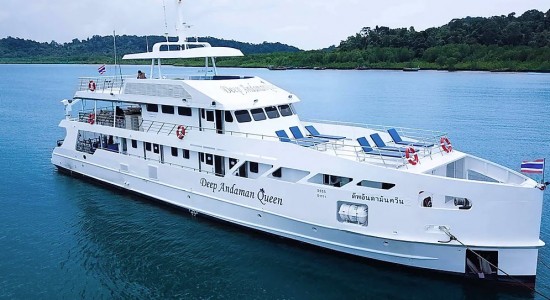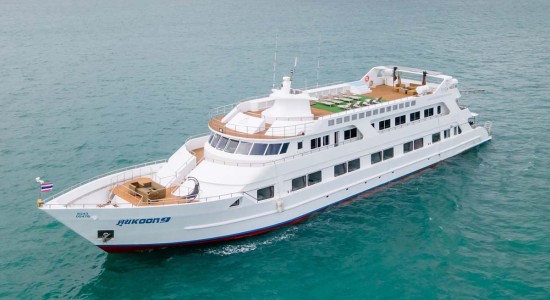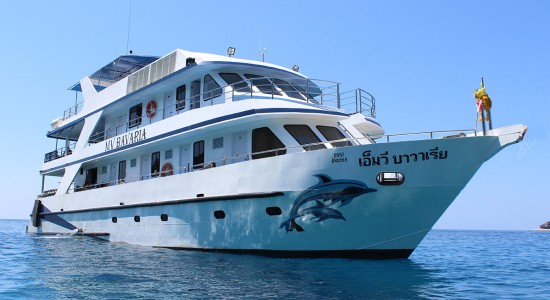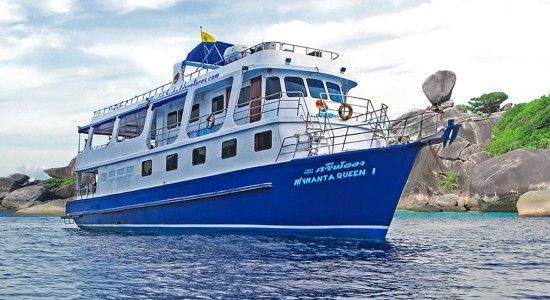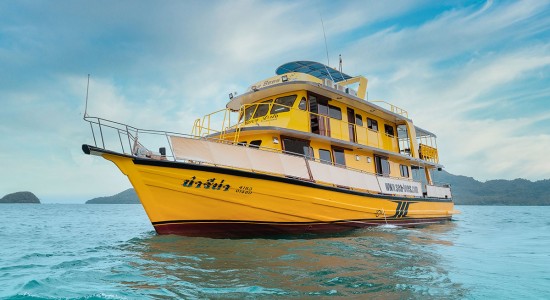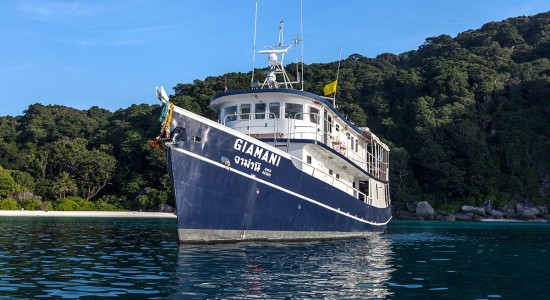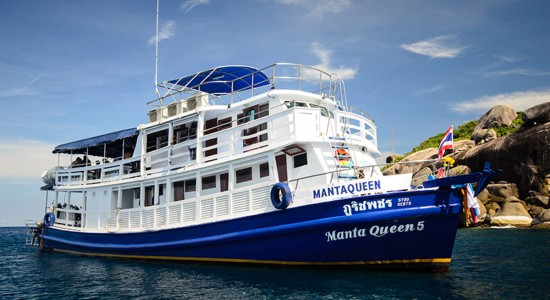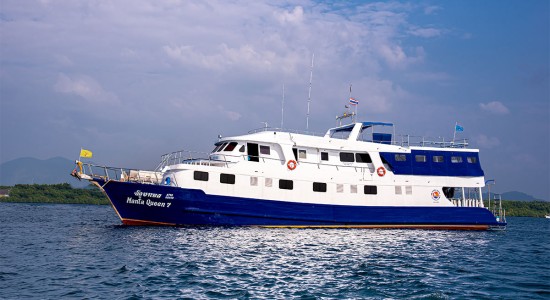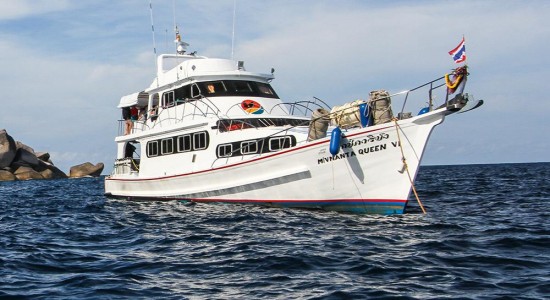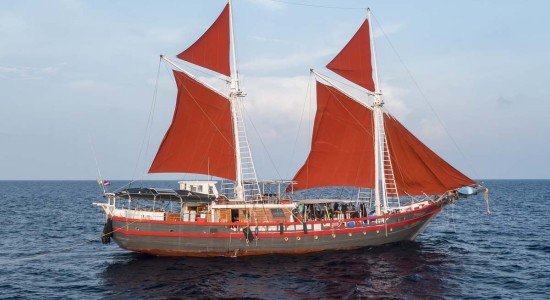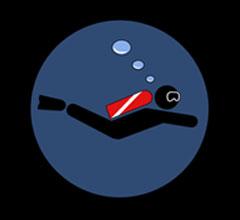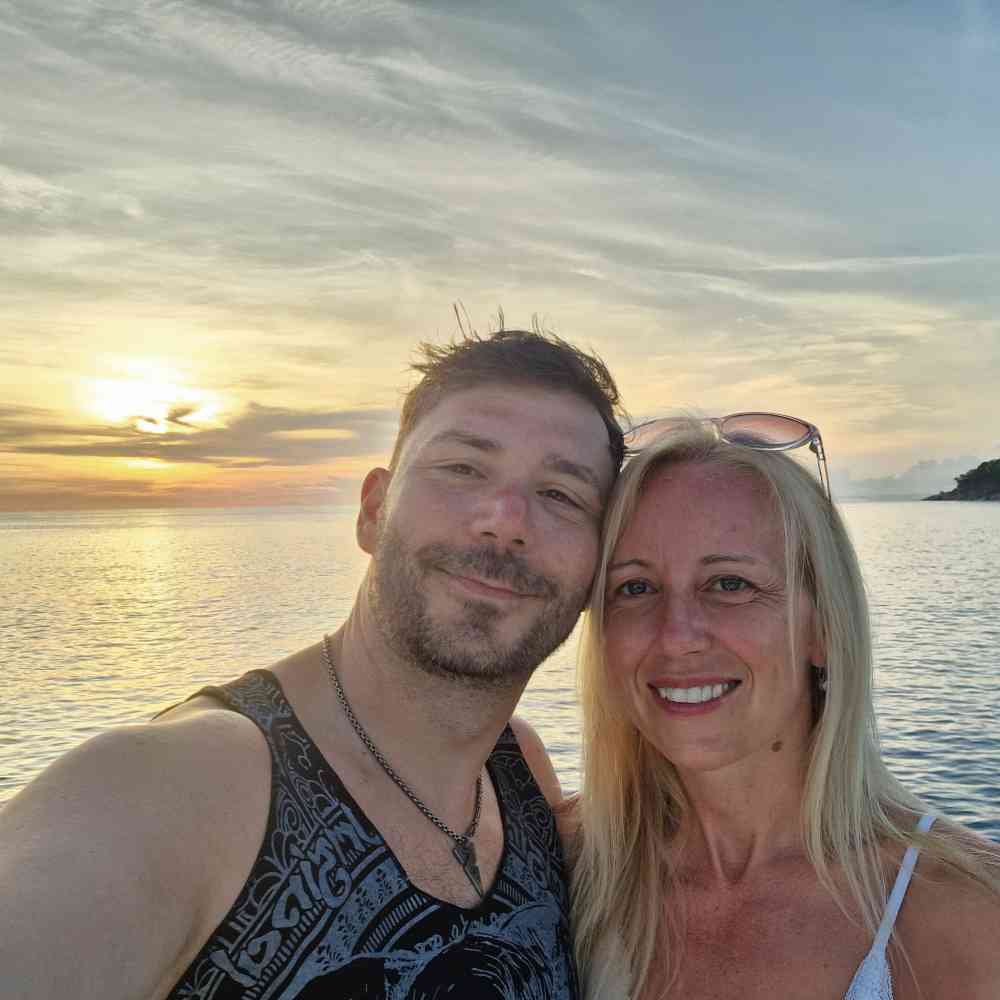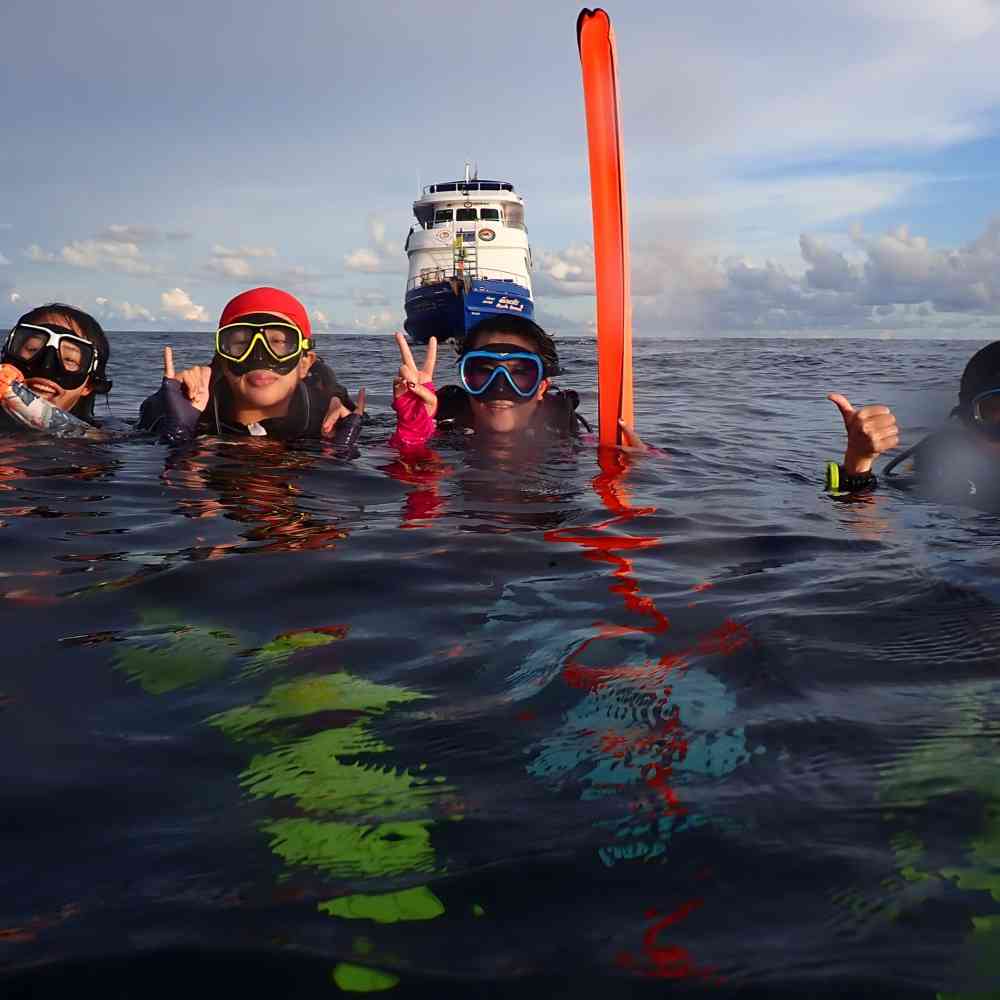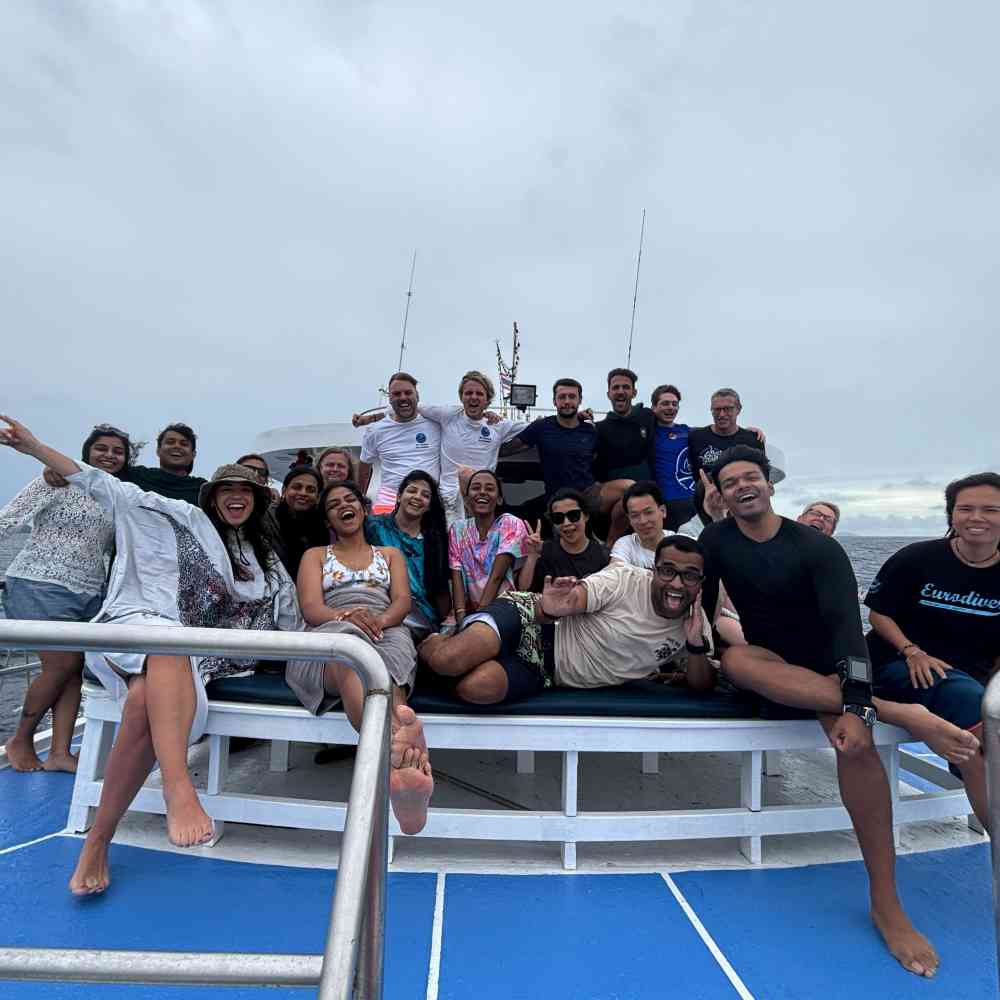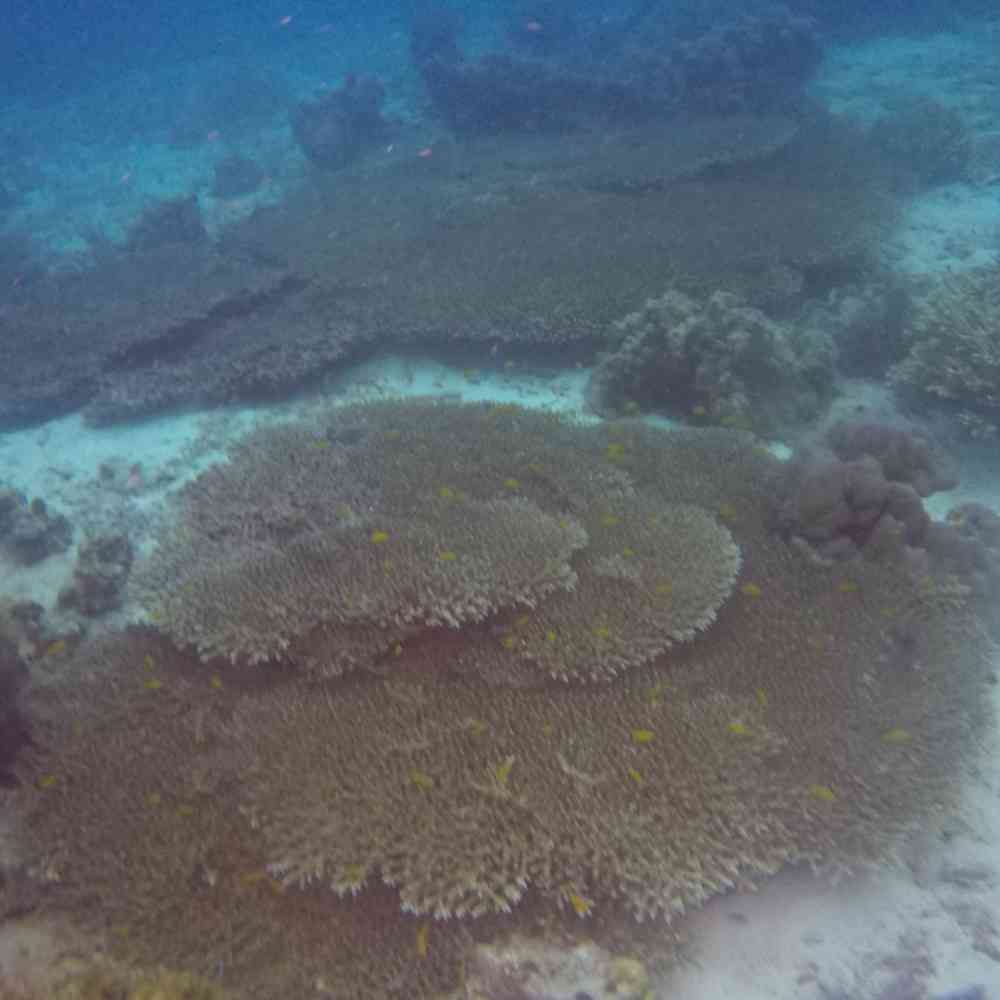Thailand’s best diving area is without doubt its westernmost islands and reefs, 60 kilometres from Phang Nga’s mainland. The Similan and Surin National Marine Parks are home to The Similan Islands, Koh Bon, Koh Tachai, and the world-famous Richelieu Rock. The remote location of these uninhabited islands and underwater pinnacles maintains their healthy corals and marine life, and keeps pollution and human encroachment to an absolute minimum. However, the distance from the mainland means that visiting these islands to scuba dive is best done on a liveaboard boat. While two days and one night on a flexible liveaboard is one of our most popular trip lengths, to fully enjoy all of the best diving sites in Thailand, four days and four nights is the ideal time to spend at sea. Staying on a Similan liveaboard boat enables you to fully immerse yourself in the experience, and get to dive early in the morning and late in the day (or at night) when the day trip boats either haven’t arrived yet or have already left. There are also plenty of other reasons why a diving liveaboard at The Similan Islands is the best way to experience these dive sites. These include the social side of things, increasing your diving ability and experience, and saving money on hotels and meals while on vacation.
There are too many Similan liveaboard boats and trips to choose from. Where do I start?
Think about what’s most important to you out of budget, trip length, your travel dates, & how much luxury you need
- Budget is the most important factor for most scuba divers who want to join a scuba diving liveaboard trip to the Similan Islands. Apart from the lucky few, most of us regular folk need to think about the cost of things which aren't necesary for everyday life. Such as holidays, fashion goods, electrical gadgets and more. Therefore, the price of a trip is usually the first thing that we look at before trying to make a shortlist of which boats to choose from. Our best-value Similan liveaboard boat is one that has been offering backpacker-price trips for more than 23 years. Nangnuan takes up to eight diving guests on trips for three days and two nights to The Similan Islands & Koh Bon. However, you don’t need to compromise too much to enjoy a budget Similan liveaboard trip. Pretty much all our other boats have air-conditioned cabins and plenty of areas to socialise or relax in peace. As the prices of trip increase, the level of comfort and luxury does too. Our price list page is probably the best way to select a Similan liveaboard based on the price you will pay.
- Trip length is also very important, especially for people who aren’t 100% comfortable sleeping on a boat, sharing a cabin with strangers, or those who need to be connected to the internet every day. Luckily, we have the widest selection of trip lengths for liveaboard Similan trips. These start at two days & one night, with six dives. We call these ‘overnight’ trips and they are ideal for people who want the liveaboard experience, including an early morning and sunset dive, but don’t want to be away for too long. Trips of three or four days in length are the most popular, so that divers can visit a good selection of the dive sites without rushing or missing anything special out. In recent years, five-day five-night trips have become more popular, and these enable divers to fully immerse themselves in the scuba diving life. These trips give 18-19 dives, ensuring that nothing is missed, and the best dive sites are repeated. Longer than five nights on board a Similan liveaboard is also possible, with Marco Polo staying out for six nights and offering up to 22 dives per trip. Any trips longer than Marco Polo’s usually include venturing round to the ‘southern islands’ of Koh Haa, Koh Phi Phi & Hin Daeng/Muang.
- Your schedule is usually as important as your budget. Unless you’re travelling alone or with a like-minded partner, compromises need to be made to keep everyone happy. Don’t forget that your partner or friends may want to do more shopping, trekking, relaxing by the pool or partying than staying on a diving boat. Also, flights and work schedules tend to get in the way of diving, and the freedom of sailing the seas on a diving liveaboard comes at the cost of having to work to pay for it or keep others happy for whatever reason. Planning a liveaboard diving trip usually needs to fit in with a particular set of events, such as a flight or hotel booking. We have several ways to help you choose the right trip to fit your schedule, which include our ‘date picker’ that can be found on most pages, our flexible boats, and just emailing us to ask. The date picker also has a filter so that you can select types of trips that are most relevant to you, thus reducing the list to choose from.
- Comfort & luxury are impossible to quantify because everyone has a different idea of what is ‘good enough’ for them to enjoy a diving liveaboard for two days or up to a week on a diving boat shared with others. For some, a clean bed that isn’t too far from a toilet & bathroom is enough. Others need a little more privacy, and space to store unpacked luggage and maybe a dressing table. Then there are those who need lots of space and privacy in their cabin and particular facilities as well. It’s impossible to keep everyone happy, but to fully enjoy your Similan liveaboard experience it’s important to be comfortable in your surroundings, and to be sure that your partner, family or friend are also comfortable. Because if they’re not, you will pay for it in the long run! Most of our Similan liveaboard boats’ pages have all the necessary details to show and explain what facilities are in each cabin and the communal areas, but if you’re at all unsure, please just ask us.
What are the main differences between the Similan diving liveaboard boats?
Most of our liveaboard diving boats look quite similar. They vary in size, guest capacity, and facilities, but they nearly all follow a standard design pattern that has been proven to work over decades of experiments and modifications. Some of them used to be fishing boats which have been modified to become scuba diving liveaboards. These modifications include fitting air-conditioned guest cabins, a clean & usable communal dining area, and a rear deck that can accommodate the diving gear, tanks and be dived from and climbed back on to. Generally, the hulls, engines and crew quarters aren’t modified very much. With the ever-increasing popularity of scuba diving at The Similan Islands, more boats are required to satisfy the demand. Thus, many of the newer scuba diving liveaboard boats are purpose built for scuba diving. In general, the purpose-built diving boats tend to be slightly larger than the modified fishing boats, because space is so valuable to either satisfy guests or to squeeze as many in as possible. Also, they are normally constructed using steel for the hull, instead of wood. Steel hulls offer better strength and are easier to make compared to shaping wood. Wood is cheaper to buy the material, but involves more labour to shape. For you, the diving customer, there’s not a great deal of difference. Wooden hulls may creak a bit and make some other noises, but they also tend to have a ‘warmer feeling’ if that’s easy to understand. Also, steel is better for larger boats, which explains why it is chosen for the larger purpose-built liveaboards at The Similans. Other differences between boats that may not appear obvious when you look at the pictures include things like more comfortable communal areas and private bathrooms in the cabins. All of the boats have at least one ‘hang-out area’ where meals are served and eaten, and most guests socialise when not diving. These areas are normally outdoors but covered, and have removable weather sheets to protect from strong winds and rain. On most boats, the dive briefings are done here, and this is where meals should be eaten. The larger and more luxurious diving liveaboard boats also have an indoor lounge saloon that is air-conditioned. This enables for some respite from the sun and heat, and can also be used for boat or dive briefings, as well as watching movies, such as the day’s diving action or a Hollywood DVD. It’s normally forbidden to eat food, smoke or wear wet clothing in the lounge saloons. Larger liveaboard boats tend to have cabins for maximum two guests, compared to 3, 4 or even 6 bed dorm cabins in some budget Similan liveaboards. And the better boats’ cabins have private en suite bathrooms for most or all of the cabins. Nearly all of the liveaboard boats in our fleet have AV entertainment systems, where guests or the staff can play videos or photo slideshows, but usually after a long day’s diving, the socialising is quickly followed by sleep. As for support vessels, almost all of the liveaboard boats have tender dinghies to transfer guests to the pristine Similan beaches on Islands #4 & #8, and to sometimes retrieve divers who have surfaced further than planned from the main boat. Normally, dives start and finsih at the rear of the main boat, and not from the tender dinghies.
What are Flexible/Platform Liveaboard Boats?
Flexible liveaboards are also referred to as ‘platform boats’ and the actual boats are no different from a normal diving liveaboard that offers scheduled trips. The differences are in the way the trips are run, and guests transferred. On a regular liveaboard trip the main boat departs with the guests, staff, equipment, fuel, water & food all on board. 3, 4, 5 or more days later, the same boat returns with the same people on board. However, flexible/platform boats work in a very different way. The main boat stays out at sea for many months, usually all season long. It sails around the dive sites on a weekly schedule, visiting certain dive sites on each day. Platform boats at the Similans do not stay in one place. They move around to up to four different locations in one day, but only stay at one dive site longer if it’s a very special one, such as Richelieu Rock. You may be wondering how the guests & provisions such as food, water and fuel, arrive at the flexible platform diving boats at The Similans. Well, it’s quite simple. They are transferred by speedboat in the morning of almost every day of the diving season. The speedboats can travel out to the main boat in a little over an hour, ensuring that more time is spent on the liveaboard than travelling. Diving guests sleep on the liveaboard for 1, 2, or 3 nights, then return in the afternoon on their final day. The speedboat usually goes back and forth every day: taking new divers and provisions out in the morning, and at he end of each day they bring guests who have finished their trips and any trash back to Khao Lak’s Tab Lamu Pier. Divers who just stay for one night on a platform boat get to do 6 dives, usually at 6 different diving locations. After arriving mid-morning on the first day, they get three dives, before dinner. Then on the second day, they are able to join the early morning dive, plus mid-morning and after-lunch dives before joining the speedboat transfer back to Khao Lak. Those who stay on a platform boat for two or three nights get 4 more dives per day. Therefore, a three-day, two-night trip is 10 dives (3+4+3) and a four-day, three-night trip is 14 dives (3+4+4+3). The advantage of joining a flexible diving liveaboard at the Similan Islands is that you can choose which day you join, and for how long you stay. With regular scheduled trips, it’s not possible to come and go on your chosen dates. Some would call it an advantage, while others may disagree, but on flexible trips you depart in the morning and you’re diving no later than10.30am. But on scheduled trips you normally depart in the evening and the first dive of the trip is early the following morning. Whichever is best depends on personal preference. However, something that is regarded by most as a disadvantage of flexible trips is that the people on the boat are always changing. The dive staff and other guests come and go depending on their own personal circumstances and choices. On one day you may be diving with a particular Divemaster guide and/or other guests, then the following day with someone else. While this can be a blessing if the other guests are boring or annoying, it’s generally a nuisance to keep changing.
What do I get for my money, and what extras do I need to pay for?
Included: All of our Similan Islands live aboard boats include full-board accommodation for the whole trip in the advertised prices. This means that each guest has his or her own bed for each night on board, plus meals and drinking water, and usually tea & coffee. The sleeping accommodation depends on the cabin selected and the boat. Some cabins are dormitory type and have 3, 4, or even 6 beds. Most cabins are for two people, in a twin or double-bed configuration. The twin-bed cabins are sometimes bunk style, and sometimes side by side. Nangnuan is the only boat that doesn’t have beds, but each guest has a sleeping space on the covered top deck of the boat. Meals are served buffet style at three set times per day, and there are always snacks and fruits available all the time to keep your energy levels up. Most of our Similan liveaboard boat trips also include free transfers before and after the trip. These transfers are not a free taxi whenever and from wherever the guest wants. They are at set times on departure and return days, and from within a limited area. Guests are transported in minivans or in local pickup taxis, and they share with other guests on the same trip. Divers from outside of the free pickup zone, or wanting to pick collected at a time that doesn’t fall within the set times, can ask for us to arrange a private taxi at a very competitive rate.
Also included in the rates are the services of Divemaster guide, which is a qualified and experienced professional to lead you around the dive sites, or to teach you a particular diving course. Even diving guests who are very experienced or professional must follow their Similan diving guide. This is for safety reasons and to make sure that the rules of the boat and the marine parks are adhered to.
Scuba divers need to breathe from heavy aluminium tanks, and be weighted down by several kilogrammes of lead. These items are not things that can be taken on vacation and loaded into luggage on a flight, so in all cases the use of standard-size (12-litre) tanks and the lead weights and weightbelts is included in the prices we advertise.
Necessary extras: All guests on our liveaboard (divers, non-divers, children & Thai nationals) need to pay National Marine Park Fees. These fees are calculated depending on if the guest is an adult, a child or a Thai. Our liveaboard diving trips enter one or both of the Mu Koh Similan and Mu Koh Surin National Marine Parks. Trips which visit Richelieu Rock enter the Surin park, and all other trips are within the Similan park. As of 2017, the entry fee for foreign adults is 500 THB. Thais and all children pay less. Divers (adults, children & Thais) all pay a diving fee, which is currently 200 THB per diving day. Therefore, a typical four-day four-night liveaboard trip will incur park fees of 1,800 THB / diver. This is 500 THB x2 plus 200 THB x4.
Some of our divers have their own diving equipment, which might be a full or partial set. A standard set of diving equipment includes a mask, fins, BCD, wetsuit and regs. All of our boats and dive centres offer for rent high-quality diving equipment which is in good condition. It is necessary to organise your rental equipment needs before departure. If you lose or break any item of diving equipment that you have rented from the boat or dive centre, you will need to pay a fixed replacement fee. If you lose one fin, you will need to pay for a replacement pair of fins that are of equal quality to the originals. Sometimes guests in this situation want to go and buy the replacements themselves, after seeing cheaper but low-quality items for sale in shops. This is not an option, because there is a great disparity in the quality and life expectancy of diving and snorkelling gear (such as fins).
Optional extras: While some of our boats offer soft drinks (sodas) for free, most charge a nominal fee, which is less than local restaurants and only a little more than the supermarket retail price (20-30 THB/can is normal). The same goes for beer, which can be purchased on all of our boats. The average price for a 330ml. can of local beer is 80 THB. Guests who want to bring their own food and/or drinks onto a diving liveaboard should always check the policy of the boat before buying anything to bring themselves.
Paying Tips is quite normal on liveaboard cruises around the world, and Thailand is no different. We feel that in any service or industry any tip or gratuity should be the idea of the customer, and it should be earned by the staff giving a service above and beyond what is expected of them within their job description and salary. However, in reality this is not the case. Almost all liveaboard trips end with a debriefing and final thank you to all on board. This is when the ‘Tip Box’ is normally introduced by the tour leader, who will mention how hard the crew worked during the trip. They may also mention that the local crew are paid a low salary and almost rely on tips. In addition, they are likely to mention that your Divemaster guide did a great job, and tips are always welcome. Some boats ‘pool’ the dive guide tips and others suggest that you should tip your own guide directly. We feel that asking for tips, or even suggesting them, is inappropriate, and that a tip should come from the guests’ hearts. Also, some cultures don’t tip, while others expect to. We can’t control what is said and expected on the liveaboards, but we like to prepare our guests in advance with this information.
